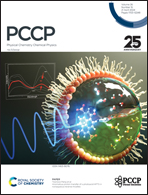Adsorbate dissociation due to heteromolecular electronic energy transfer from fluorobenzene thin films†
Abstract
Study of the near-UV photodissociation dynamics for monolayer (ML) quantities of CH3I on thin films of a series of fluorobenzenes and benzene (1–25 ML) grown on a Cu(100) substrate finds that in addition to gas-phase-like neutral photodissociation, CH3I dissociation can be enhanced via electronic energy transfer to the CH3I following photoabsorption in several of the thin films studied. Distinct CH3 photofragment kinetic energy distributions are found for CH3I photodissociation on C6H5F, 1,4-C6H4F2 and C6H6 thin films, and distinguished from neutral photodissociation pathways using polarized incident light. The effective photodissociation cross section for CH3I on these thin films is increased as compared to that for the higher F-count fluorobenzene thin films due to the additional photodissociation pathway available. Quenching by the metal substrate of the photoexcitation via this new pathway suggests a significantly longer timescale for excitation than that of neutral CH3I photodissociation. The observations support a mechanism in which neutral photoexcitation in the thin film (i.e. an exciton) is transported to the interface with CH3I, and transfers the electronic excitation to the CH3I which then dissociates. The unimodal CH3 photofragment distribution and observed kinetic energies on the fluorobenzene thin films suggest that the dissociation occurs via the 3Q1 excited state of CH3I.



 Please wait while we load your content...
Please wait while we load your content...